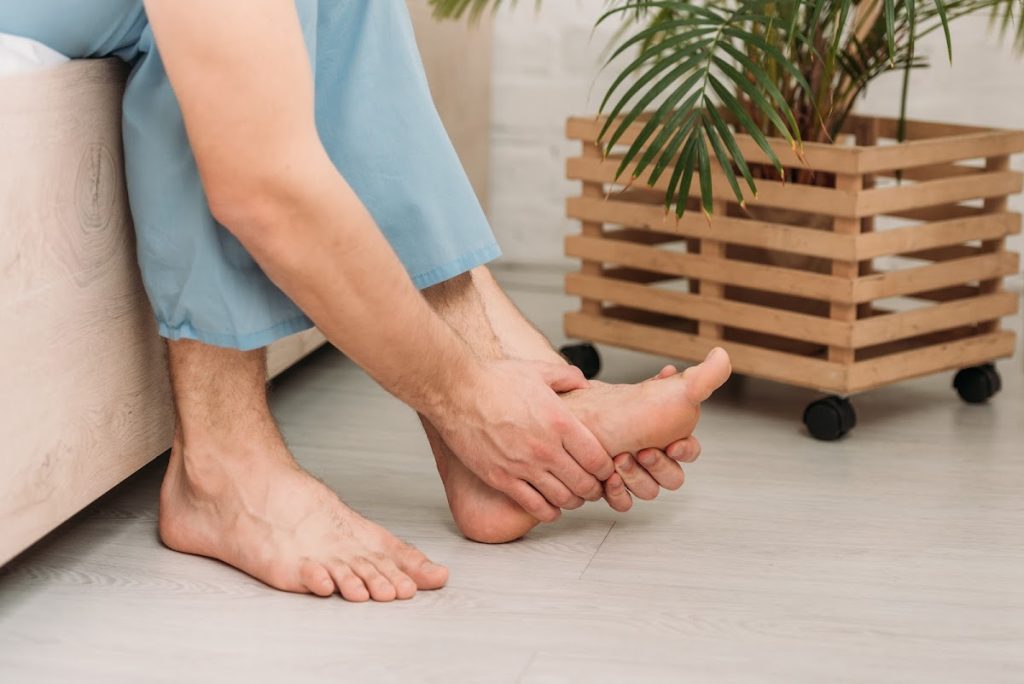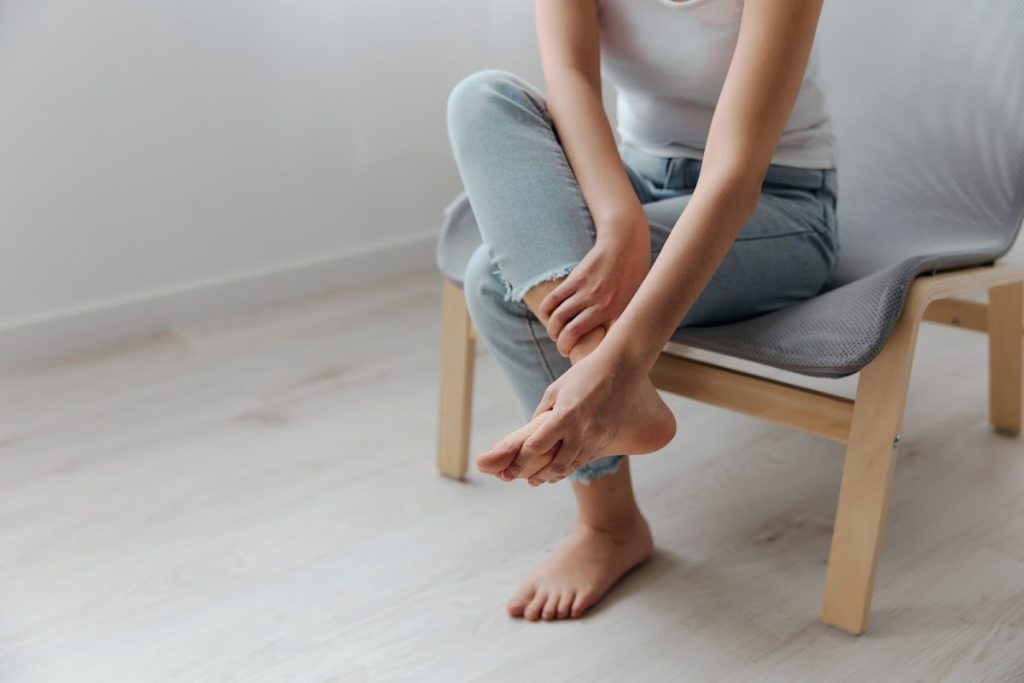Heel pain can transform your every step into a jarring reminder of discomfort. Imagine waking up, placing your foot on the ground, and being greeted by a stabbing pain at the bottom of your heel. This relentless agony often signals conditions like plantar fasciitis or Achilles tendinitis, which are more common than you might think.
At Southernmost Foot & Ankle Specialists, we understand the urgency of effective heel pain treatment. Our state-of-the-art facilities and expert care ensure you walk away with relief and lasting solutions. Let’s uncover the causes, symptoms, and cutting-edge treatments for heel pain, helping you reclaim the comfort of every step.
 What Are The Common Causes Of Heel Pain?
What Are The Common Causes Of Heel Pain?
The journey to understanding heel pain begins beneath the surface, where intricate structures of bone, tendon, ligament, and tissue come together to form the foot. Several factors can disrupt this delicate balance, leading to pain. Here’s a closer look:
1. Plantar Fasciitis
Standing at the forefront of heel pain causes, plantar fasciitis occurs when there’s inflammation of the plantar fascia—the fibrous tissue band running across the bottom of your foot, connecting your heel bone to your toes. This condition can cause intense pain, often felt most acutely with the first steps in the morning or after prolonged periods of rest.
2. Achilles Tendinitis
Named after the legendary Greek hero, the Achilles tendon is vital for walking, running, and jumping. Achilles tendinitis results from overuse, leading to inflammation of this robust tendon that connects the calf muscles to the heel bone. It is a common affliction among runners and athletes who suddenly increase the intensity or duration of their workouts.
3. Heel Spurs
These are bony growths that develop on the underside of the heel bone, often forming over many months. Heel spurs are frequently associated with plantar fasciitis and can arise from ongoing muscle and ligament strain, stretching of the plantar fascia, and tearing of the membrane that covers the heel bone.
4. Bursitis
Bursae are small fluid-filled sacs that cushion the bones, tendons, and muscles near joints. When the bursae become inflamed, it leads to bursitis. Though less common in the heel, bursitis can cause significant pain, resembling the symptoms of Achilles tendinitis.
5. Stress Fractures
Athletes or individuals engaging in repetitive impact activities may experience stress fractures; which are small cracks in the heel bone. Insufficient rest, improper footwear, or surfaces that do not absorb impact well can contribute to the development of stress fractures.
Understanding the cause of heel pain is a critical step toward recovery. Each condition has unique characteristics and, as such, requires a tailored approach to treatment. By recognizing the early signs and seeking professional advice from Southernmost Foot & Ankle Specialists, you can address the underlying issue and take confident strides toward regaining comfort and mobility.
Diagnosis And Treatment Of Heel Pain
Accurate diagnosis is the cornerstone of effective treatment for heel pain. Identifying the underlying cause of discomfort requires a methodical approach, typically beginning with a consultation with a healthcare professional. Here’s how the process unfolds:
1. Physical Examination
The first step is often a thorough physical exam, where your doctor will look for areas of tenderness, swelling, redness, or stiffness in the foot. They’ll assess your gait, the alignment of your feet, and how pain manifests when you stand, walk, or stretch.
2. Medical History Review
Your doctor will inquire about your medical history, including any prior incidents of heel pain or foot problems. They may also ask about the types of activities you engage in, as this can often give clues about potential causes.
3. Imaging Tests
To gain a clearer picture of what’s happening inside your foot, your doctor might order imaging studies. Common modalities include:
- X-rays: These can reveal bone spurs and other abnormalities in the bone structure.
- MRI (Magnetic Resonance Imaging): MRIs can provide detailed images of both hard and soft tissues, identifying issues like plantar fasciitis or stress fractures.
- Ultrasound: Often used for soft-tissue injuries, an ultrasound can show tears or inflammation in the plantar fascia or Achilles tendon.
- Bone scan: Occasionally used when the diagnosis is unclear, a bone scan can detect stress fractures, bone tumors, or other bone-related conditions.
By combining these diagnostic tools with the clinical examination, healthcare providers can pinpoint the source of heel pain and tailor an effective treatment plan to your specific needs. Only through understanding the root cause can a targeted and successful path to recovery be charted.
Best Practices For Tackling Heel Pain
Once the specific cause of heel pain is diagnosed, a treatment plan can be devised. Recovery involves managing pain, reducing inflammation, strengthening foot structures, and preventing recurrence. Here are some of the best practice approaches:
1. Rest and Ice
Initial treatment often includes rest and ice to reduce pain and swelling. Limit activities that put stress on your heels, such as running and jumping. Apply ice to the affected area for 15-20 minutes several times a day, especially after activity.
2. Proper Footwear
Switching to shoes that support and cushion the heel, arch, and overall structure of the foot is crucial. Orthotic inserts or custom-designed foot supports may be advised by your healthcare provider to alleviate pain and correct structural issues.
3. Exercises and Stretching
Specific exercises and stretches can strengthen the muscles and tendons in your feet, improving overall function and reducing stress on the heel. Common practices might include calf stretches, plantar fascia stretches, and toe flexor exercises.
4. Medication
Over-the-counter pain relievers such as ibuprofen or acetaminophen can help reduce pain and inflammation. For more severe cases, your doctor might prescribe stronger anti-inflammatory medications or corticosteroids.
5. Physical Therapy
A physiotherapist can teach you exercises to strengthen your lower leg and foot muscles, improve stability and mobility, and relieve pain. Physical therapy techniques might also include massage, ultrasound treatments, or electrical nerve stimulation.
6. Advanced Treatments
For chronic or severe cases, more advanced treatments such as shock wave therapy or surgery may be necessary. Shock wave therapy stimulates healing within the foot using sound waves, and surgery may be required to correct structural issues if other treatments do not relieve pain.
7. Lifestyle Modifications
Consider how your lifestyle might impact your heel pain. Weight management and modifications to your exercise routines are often necessary to alleviate pressure on the heels and prevent future issues.
By following these best practices for tackling heel pain, you can regain mobility and improve your quality of life. Remember, each person’s situation is unique, so what works for one individual might not work for another. Working closely with healthcare professionals to monitor progress and adjust treatments as necessary is key to a successful recovery.

How To Prevent Heel Pain
Preventing heel pain involves a combination of smart habits, awareness, and self-care. Here are some strategies to help keep your feet healthy and pain-free:
1. Maintain a Healthy Weight
Extra pounds put additional stress on your heels and feet. Maintaining a healthy weight can significantly reduce the risk of developing heel pain.
2. Wear Appropriate Shoes
Choose shoes that fit well and offer proper support, especially if you spend a lot of time on your feet. Avoid wearing high heels for extended periods and replace worn-out exercise shoes regularly to ensure adequate cushioning and support.
3. Stretch Regularly
Incorporate stretching into your daily routine, focusing on the calf muscles and the plantar fascia. Regular stretching can improve flexibility, reduce tightness, and help prevent injuries that lead to heel pain.
4. Gradually Increase Activity
If you’re starting a new exercise program or increasing your activity level, do so gradually. Sudden increases in mileage or intensity can strain the muscles and tendons in your feet, leading to pain.
5. Warm-Up Before Exercise
Warm-up exercises help prepare your body for physical activity and reduce the risk of injury. Always include a dynamic warm-up before starting your workout to prevent heel pain and other injuries.
6. Listen to Your Body
Pay attention to the signals your body sends. If you start to feel pain in your heels, rest and assess what may be causing the discomfort. Continuing to push through pain can lead to more serious issues.
7. Strengthen and Condition
Strengthening exercises for the feet, ankles, and lower leg muscles can improve stability, reduce stress on the heels, and prevent pain. Incorporating balance and proprioceptive exercises into your routine can also help.
8. Nutrition and Hydration
Good nutrition and hydration support the health of your muscles, bones, and tendons. Ensure you’re getting adequate calcium and vitamin D for bone strength, and stay hydrated to support overall tissue health.
By implementing these preventive measures, you can minimize your risk of developing heel pain and ensure your feet remain strong, flexible, and free from injury.
Regaining Your Stride
Overcoming heel pain is a journey. With the right approach, patience, and sometimes professional help, you can regain your stride. Remember not to rush recovery, as this can lead to further injury. Always consult with a healthcare professional before starting any new treatment regimen.
Walk Pain-Free!
Don’t let heel pain hold you back. Educate yourself, seek the right treatment, and take the steps (literally and figuratively) toward a pain-free life. It’s not just about walking without discomfort; it’s about regaining the quality of life that everyone deserves.
Living free of heel pain is not just a dream; it’s a reality for many under our care. Ready to join the ranks of those who’ve conquered heel pain? Discover how expert treatment and dedication can change your life. Our specialists are here to guide you every step of the way.
COMMITTED
TO EXCELLENT SERVICE
Our philosophy has been that the patient always comes first.
EMERGENCY OPERATOR
24 HOURS
Get emergency care from a specialist right from the start. Don’t go to an urgent care, ER or general doctor. Come straight the specialist.


 What Are The Common Causes Of Heel Pain?
What Are The Common Causes Of Heel Pain?